JavaScript数据结构——字典和散列表的实现
在前一篇文章中,我们介绍了如何在JavaScript中实现集合。字典和集合的主要区别就在于,集合中数据是以[值,值]的形式保存的,我们只关心值本身;而在字典和散列表中数据是以[键,值]的形式保存的,键不能重复,我们不仅关心键,也关心键所对应的值。
我们也可以把字典称之为映射表。由于字典和集合很相似,我们可以在前一篇文章中的集合类Set的基础上来实现我们的字典类Dictionary。与Set类相似,ES6的原生Map类已经实现了字典的全部功能,稍后我们会介绍它的用法。
下面是我们的Dictionary字典类的实现代码:
class Dictionary { constructor () { this.items = {}; } set (key, value) { // 向字典中添加或修改元素 this.items[key] = value; } get (key) { // 通过键值查找字典中的值 return this.items[key]; } delete (key) { // 通过使用键值来从字典中删除对应的元素 if (this.has(key)) { delete this.items[key]; return true; } return false; } has (key) { // 判断给定的键值是否存在于字典中 return this.items.hasOwnProperty(key); } clear() { // 清空字典内容 this.items = {}; } size () { // 返回字典中所有元素的数量 return Object.keys(this.items).length; } keys () { // 返回字典中所有的键值 return Object.keys(this.items); } values () { // 返回字典中所有的值 return Object.values(this.items); } getItems () { // 返回字典中的所有元素 return this.items; } }
与Set类很相似,只是把其中value的部分替换成了key。我们来看看一些测试用例:
let Dictionary = require('./dictionary');
let dictionary = new Dictionary();
dictionary.set('Gandalf', 'gandalf@email.com');
dictionary.set('John', 'john@email.com');
dictionary.set('Tyrion', 'tyrion@email.com');
console.log(dictionary.has('Gandalf')); // true
console.log(dictionary.size()); // 3
console.log(dictionary.keys()); // [ 'Gandalf', 'John', 'Tyrion' ]
console.log(dictionary.values()); // [ 'gandalf@email.com', 'john@email.com', 'tyrion@email.com' ]
console.log(dictionary.get('Tyrion')); // tyrion@email.com
dictionary.delete('John');
console.log(dictionary.keys()); // [ 'Gandalf', 'Tyrion' ]
console.log(dictionary.values()); // [ 'gandalf@email.com', 'tyrion@email.com' ]
console.log(dictionary.getItems()); // { Gandalf: 'gandalf@email.com', Tyrion: 'tyrion@email.com' }
相应地,下面是使用ES6的原生Map类的测试结果:
let dictionary = new Map(); dictionary.set('Gandalf', 'gandalf@email.com'); dictionary.set('John', 'john@email.com'); dictionary.set('Tyrion', 'tyrion@email.com'); console.log(dictionary.has('Gandalf')); // true console.log(dictionary.size); // 3 console.log(dictionary.keys()); // [Map Iterator] { 'Gandalf', 'John', 'Tyrion' } console.log(dictionary.values()); // [Map Iterator] { 'gandalf@email.com', 'john@email.com', 'tyrion@email.com' } console.log(dictionary.get('Tyrion')); // tyrion@email.com dictionary.delete('John'); console.log(dictionary.keys()); // [Map Iterator] { 'Gandalf', 'Tyrion' } console.log(dictionary.values()); // [Map Iterator] { 'gandalf@email.com', 'tyrion@email.com' } console.log(dictionary.entries()); // [Map Iterator] { [ Gandalf: 'gandalf@email.com' ], [ Tyrion: 'tyrion@email.com' ] }
和前面我们自定义的Dictionary类稍微有一点不同,values()方法和keys()方法返回的不是一个数组,而是Iterator迭代器。另一个就是这里的size是一个属性而不是方法,然后就是Map类没有getItems()方法,取而代之的是entries()方法,它返回的也是一个Iterator。有关Map类的详细详细介绍可以查看这里。
在ES6中,除了原生的Set和Map类外,还有它们的弱化版本,分别是WeakSet和WeakMap,我们在《JavaScript数据结构——栈的实现与应用》一文中已经见过WeakMap的使用了。Map和Set与它们各自的弱化版本之间的主要区别是:
- WeakSet或WeakMap类没有entries、keys和values等迭代器方法,只能通过get和set方法访问和设置其中的值。这也是为什么我们在《JavaScript数据结构——栈的实现与应用》一文中要使用WeakMap类来定义类的私有属性的原因。
- 只能用对应作为键值,或者说其中的内容只能是对象,而不能是数字、字符串、布尔值等基本数据类型。
弱化的Map和Set类主要是为了提供JavaScript代码的性能。
散列表
散列表(或者叫哈希表),是一种改进的dictionary,它将key通过一个固定的算法(散列函数或哈希函数)得出一个数字,然后将dictionary中key所对应的value存放到这个数字所对应的数组下标所包含的存储空间中。在原始的dictionary中,如果要查找某个key所对应的value,我们需要遍历整个字典。为了提高查询的效率,我们将key对应的value保存到数组里,只要key不变,使用相同的散列函数计算出来的数字就是固定的,于是就可以很快地在数组中找到你想要查找的value。下面是散列表的数据结构示意图:

下面是我们散列函数loseloseHashCode()的实现代码:
loseloseHashCode (key) { let hash = 0; for (let i = 0; i < key.length; i++) { hash += key.charCodeAt(i); } return hash % 37; }
这个散列函数的实现很简单,我们将传入的key中的每一个字符使用charCodeAt()函数(有关该函数的详细内容可以查看这里)将其转换成ASCII码,然后将这些ASCII码相加,最后用37求余,得到一个数字,这个数字就是这个key所对应的hash值。接下来要做的就是将value存放到hash值所对应的数组的存储空间内。下面是我们的HashTable类的主要实现代码:
class HashTable { constructor () { this.table = []; } loseloseHashCode (key) { // 散列函数 let hash = 0; for (let i = 0; i < key.length; i++) { hash += key.charCodeAt(i); } return hash % 37; } put (key, value) { // 将键值对存放到哈希表中 let position = this.loseloseHashCode(key); console.log(`${position} - ${key}`); this.table[position] = value; } get (key) { // 通过key查找哈希表中的值 return this.table[this.loseloseHashCode(key)]; } remove (key) { // 通过key从哈希表中删除对应的值 this.table[this.loseloseHashCode(key)] = undefined; } isEmpty () { // 判断哈希表是否为空 return this.size() === 0; } size () { // 返回哈希表的长度 let count = 0; this.table.forEach(item => { if (item !== undefined) count++; }); return count; } clear () { // 清空哈希表 this.table = []; } }
测试一下上面的这些方法:
let HashTable = require('./hashtable');
let hash = new HashTable();
hash.put('Gandalf', 'gandalf@email.com'); // 19 - Gandalf
hash.put('John', 'john@email.com'); // 29 - John
hash.put('Tyrion', 'tyrion@email.com'); // 16 - Tyrion
console.log(hash.isEmpty()); // false
console.log(hash.size()); // 3
console.log(hash.get('Gandalf')); // gandalf@email.com
console.log(hash.get('Loiane')); // undefined
hash.remove('Gandalf');
console.log(hash.get('Gandalf')); // undefined
hash.clear();
console.log(hash.size()); // 0
console.log(hash.isEmpty()); // true
为了方便查看hash值和value的对应关系,我们在put()方法中加入了一行console.log(),用来打印key的hash值和value之间的对应关系。可以看到,测试的结果和前面我们给出的示意图是一致的。
散列集合的实现和散列表类似,只不过在散列集合中不再使用键值对,而是只有值没有键。这个我们在前面介绍集合和字典的时候已经讲过了,这里不再赘述。
细心的同学可能已经发现了,这里我们提供的散列函数可能过于简单,以致于我们无法保证通过散列函数计算出来的hash值一定是唯一的。换句话说,传入不同的key值,我们有可能会得到相同的hash值。尝试一下下面这些keys:
let hash = new HashTable(); hash.put('Gandalf', 'gandalf@email.com'); hash.put('John', 'john@email.com'); hash.put('Tyrion', 'tyrion@email.com'); hash.put('Aaron', 'aaron@email.com'); hash.put('Donnie', 'donnie@email.com'); hash.put('Ana', 'ana@email.com'); hash.put('Jamie', 'jamie@email.com'); hash.put('Sue', 'sue@email.com'); hash.put('Mindy', 'mindy@email.com'); hash.put('Paul', 'paul@email.com'); hash.put('Nathan', 'nathan@email.com');
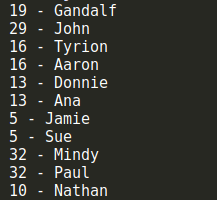
从结果中可以看到,尽管有些keys不同,但是通过我们提供的散列函数居然得到了相同的hash值,这显然违背了我们的设计原则。在哈希表中,这个叫做散列冲突,为了得到一个可靠的哈希表,我们必须尽可能地避免散列冲突。那如何避免这种冲突呢?这里介绍两种解决冲突的方法:分离链接和线性探查。
分离链接
所谓分离链接,就是将原本存储在哈希表中的值改成链表,这样在哈希表的同一个位置上,就可以存储多个不同的值。链表中的每一个元素,同时存储了key和value。示意图如下:
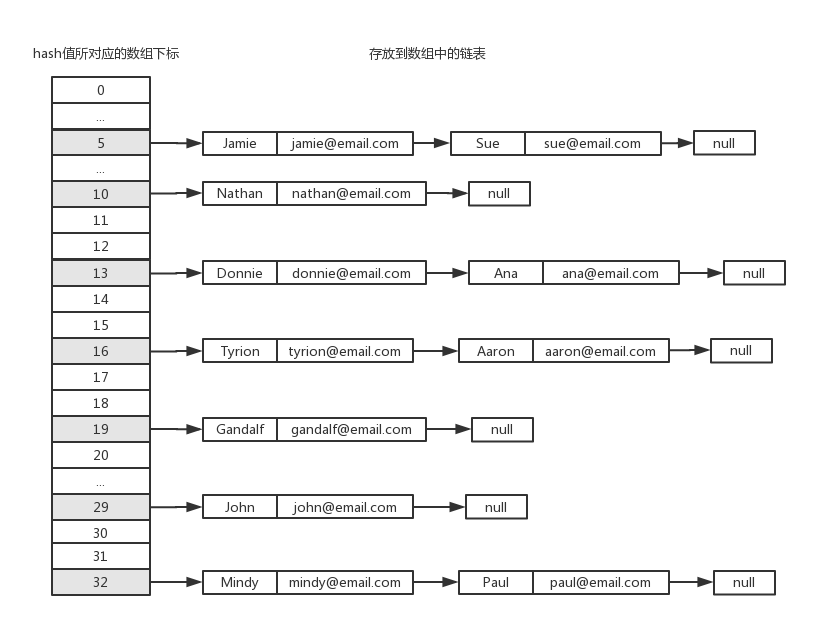
这样,当不同的key通过散列函数计算出相同的hash值时,我们只需要找到数组中对应的位置,然后往其中的链表添加新的节点即可,从而有效地避免了散列冲突。为了实现这种数据结构,我们需要定义一个新的辅助类ValuePair,它的内容如下:
let ValuePair = function (key, value) { this.key = key; this.value = value; this.toString = function () { // 提供toString()方法以方便我们测试 return `[${this.key} - ${this.value}]`; } };
ValuePair类具有两个属性,key和value,用来保存我们要存入到散列表中的元素的键值对。toString()方法在这里不是必须的,该方法是为了后面我们方便测试。
新的采用了分离链接的HashTableSeparateChaining类可以继承自前面的HashTable类,完整的代码如下:
class HashTableSeparateChaining extends HashTable { constructor () { super(); } put (key, value) { let position = this.loseloseHashCode(key); if (this.table[position] === undefined) { this.table[position] = new LinkedList(); // 单向链表,需要引入LinkedList类 } this.table[position].append(new ValuePair(key, value)); } get (key) { let position = this.loseloseHashCode(key); if (this.table[position] !== undefined) { let current = this.table[position].getHead(); while (current) { if (current.element.key === key) return current.element.value; current = current.next; } } return undefined; } remove (key) { let position = this.loseloseHashCode(key); let hash = this.table[position]; if (hash !== undefined) { let current = hash.getHead(); while (current) { if (current.element.key === key) { hash.remove(current.element); if (hash.isEmpty()) this.table[position] = undefined; return true; } current = current.next; } } return false; } size () { let count = 0; this.table.forEach(item => { if (item !== undefined) count += item.size(); }); return count; } toString() { let objString = ""; for (let i = 0; i < this.table.length; i++) { let ci = this.table[i]; if (ci === undefined) continue; objString += `${i}: `; let current = ci.getHead(); while (current) { objString += current.element.toString(); current = current.next; if (current) objString += ', '; } objString += '\r\n'; } return objString; } }
其中的LinkedList类为单向链表,具体内容可以查看《JavaScript数据结构——链表的实现与应用》。注意,现在hash数组中的每一个元素都是一个单向链表,单向链表的所有操作我们可以借助于LinkedList类来完成。我们重写了size()方法,因为现在要计算的是数组中所有链表的长度总和。
下面是HashTableSeparateChaining类的测试用例及结果:
let hash = new HashTableSeparateChaining(); hash.put('Gandalf', 'gandalf@email.com'); hash.put('John', 'john@email.com'); hash.put('Tyrion', 'tyrion@email.com'); hash.put('Aaron', 'aaron@email.com'); hash.put('Donnie', 'donnie@email.com'); hash.put('Ana', 'ana@email.com'); hash.put('Jamie', 'jamie@email.com'); hash.put('Sue', 'sue@email.com'); hash.put('Mindy', 'mindy@email.com'); hash.put('Paul', 'paul@email.com'); hash.put('Nathan', 'nathan@email.com'); console.log(hash.toString()); console.log(`size: ${hash.size()}`); console.log(hash.get('John')); console.log(hash.remove('Ana')); console.log(hash.remove('John')); console.log(hash.toString());
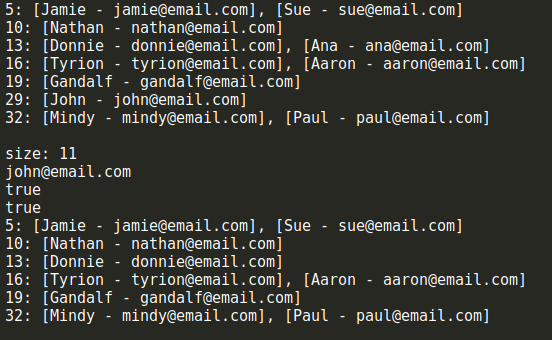
可以看到,结果和上面示意图上给出的是一致的,size()、remove()和get()方法的执行结果也符合预期。
线性探查
避免散列冲突的另一种方法是线性探查。当向哈希数组中添加某一个新元素时,如果该位置上已经有数据了,就继续尝试下一个位置,直到对应的位置上没有数据时,就在该位置上添加数据。我们将上面的例子改成线性探查的方式,存储结果如下图所示:
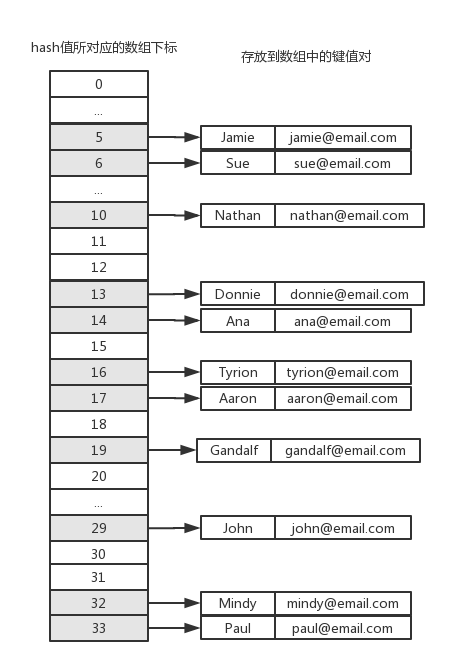
现在我们不需要单向链表LinkedList类了,但是ValuePair类仍然是需要的。同样的,我们的HashTableLinearProbing类继承自HashTable类,完整的代码如下:
class HashTableLinearProbing extends HashTable { constructor () { super(); } put (key, value) { let position = this.loseloseHashCode(key); if (this.table[position] === undefined) { this.table[position] = new ValuePair(key, value); } else { let index = position + 1; while (this.table[index] !== undefined) { index ++; } this.table[index] = new ValuePair(key, value); } } get (key) { let position = this.loseloseHashCode(key); if (this.table[position] !== undefined) { if (this.table[position].key === key) return this.table[position].value; let index = position + 1; while (this.table[index] !== undefined && this.table[index].key !== key) { index ++; } return this.table[index].value; } return undefined; } remove (key) { let position = this.loseloseHashCode(key); if (this.table[position] !== undefined) { if (this.table[position].key === key) { this.table[position] = undefined; return true; } let index = position + 1; while (this.table[index] !== undefined && this.table[index].key !== key) { index ++; } this.table[index] = undefined; return true; } return false; } toString() { let objString = ""; for (let i = 0; i < this.table.length; i++) { let ci = this.table[i]; if (ci === undefined) continue; objString += `${i}: ${ci}\r\n`; } return objString; } }
使用上面和HashTableSeparateChaining类相同的测试用例,我们来看看测试结果:
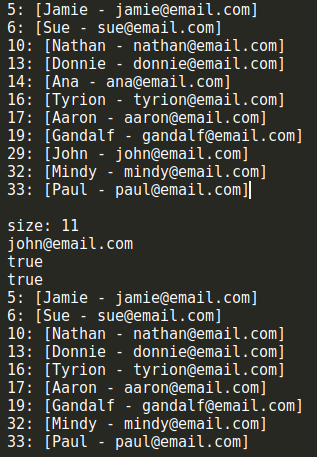
可以和HashTableSeparateChaining类的测试结果比较一下,多出来的位置6、14、17、33,正是HashTableSeparateChaining类中每一个链表的剩余部分。get()和remove()方法也能正常工作,我们不需要重写size()方法,和基类HashTable中一样,hash数组中每一个位置只保存了一个元素。另一个要注意的地方是,由于JavaScript中定义数组时不需要提前给出数组的长度,因此我们可以很容易地利用JavaScript语言的这一特性来实现线性探查。在某些编程语言中,数组的定义是必须明确给出长度的,这时我们就需要重新考虑我们的HashLinearProbing类的实现了。
loseloseHashCode()散列函数并不是一个表现良好的散列函数,正如你所看到的,它会很轻易地产生散列冲突。一个表现良好的散列函数必须能够尽可能低地减少散列冲突,并提高性能。我们可以在网上找一些不同的散列函数的实现方法,下面是一个比loseloseHashCode()更好的散列函数djb2HashCode():
djb2HashCode (key) { let hash = 5381; for (let i = 0; i < key.length; i++) { hash = hash * 33 + key.charCodeAt(i); } return hash % 1013; }
我们用相同的测试用例来测试dj2HashCode(),下面是测试结果:
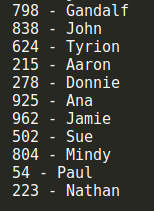
这次没有冲突!然而这并不是最好的散列函数,但它是社区最推崇的散列函数之一。
下一章我们将介绍如何用JavaScript来实现树。





 浙公网安备 33010602011771号
浙公网安备 33010602011771号